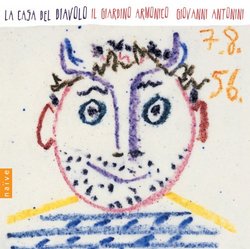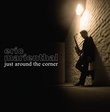| All Artists: Christoph Willibald Gluck, Carl Philipp Emanuel Bach, Pietro Antonio Locatelli, Wilhelm Friedemann Bach, Luigi Boccherini, Johann Christian Bach, Giovanni Antonini, Il Giardino Armonico, Ottavio Dantone Title: La Casa del Diavolo Members Wishing: 0 Total Copies: 1 Label: Opus 111 Release Date: 4/19/2005 Genres: Special Interest, Classical Styles: Ballets & Dances, Ballets, Chamber Music, Forms & Genres, Concertos, Historical Periods, Baroque (c.1600-1750), Classical (c.1770-1830), Instruments, Keyboard, Strings, Symphonies Number of Discs: 1 SwapaCD Credits: 1 UPC: 709861303991 |
Search - Christoph Willibald Gluck, Carl Philipp Emanuel Bach, Pietro Antonio Locatelli :: La Casa del Diavolo
 | Christoph Willibald Gluck, Carl Philipp Emanuel Bach, Pietro Antonio Locatelli La Casa del Diavolo Genres: Special Interest, Classical
![header=[] body=[This CD is available to be requested as disc only.]](/images/attributes/disc.png?v=1dc39fa5) ![header=[] body=[This CD is unavailable to be requested with the disc and back insert at this time.]](/images/attributes/greyed_disc_back.png?v=1dc39fa5) ![header=[] body=[This CD is available to be requested with the disc and front insert.]](/images/attributes/disc_front.png?v=1dc39fa5) ![header=[] body=[This CD is unavailable to be requested with the disc, front and back inserts at this time.]](/images/attributes/greyed_disc_front_back.png?v=1dc39fa5) |
Larger Image |
CD DetailsSimilar CDs
|
CD ReviewsGenerally Dramatic Music Played with Real Brio J Scott Morrison | Middlebury VT, USA | 05/02/2005 (5 out of 5 stars) "I'm not a great fan of original instrument groups, often finding that they are either wan or rough-sounding. I do agree that some performance practice changes that have come into play since the advent of this movement have been to the good, but generally I still prefer orchestral music using modern instruments. This CD, though, is something special, largely because the group recorded here, Il Giardino Armonico, led by Giovanni Antonini, is so very good. The works contained herein (Amazon hasn't gotten around as of the date of this review of listing the specific pieces) are as follows: Gluck: 'Dance of the Spectres and Furies' from the ballet 'Don Juan' (1771) Bach, CPE: Sinfonia Wq 182 No. 5 in B minor for strings and continuo Locatelli: Concerto Grosso Op. 7, No. 6 'Il pianto d'Arianna' for violin, strings and continuo Bach, Wilhelm Friedemann: Concerto in F Minor for harpsichord, strings and continuo Boccherini: Sinfonia Op. 12, No. 4, 'La Casa del Diavolo,' for 2 oboes, 2 horns, strings and continuo (1776) The Gluck is played with such ferocity that it almost makes one's skin crawl (in a good way, of course!); this is tone-painting long before Romanticism made it the norm, and it is extremely effective. What is interesting -- it helped dictate the contents of this program -- is that the last work here, the Boccherini Sinfonia (subtitled 'La Casa del Diavolo,' ends with a Chaconne based on the Gluck piece. Actually, it is a paraphrase of Gluck's piece with some degree of 'updating' from a distance of only five years. The earlier movements in Boccherini's Sinfonia also contain references to the Gluck. Where Gluck's ballet concludes with a kind of purification, achieved by a serene ending in D major, the Boccherini continues the devilish D minor tsimmis right to the very end. And an exciting performance this is, too. Locatelli's eight-movement Concerto Grosso, a violin concerto that features soloist Enrico Onofri, portrays the lament of Ariadne, a subject so beloved on Baroque composers. It is not programmatic, but the general tenor is one of longing, frustration, rage and resignation in turn. Onofri is a neat soloist and he is given neat support by the orchestra. The pieces by the two Bach sons are halfway between baroque and galant styles, both pretty dramatic in tone. The Friedmann Bach concerto features harpsichordist Ottavio Dantone. This is a well-planned program that tends toward the dramatic in tone, certainly in keeping with the overall title of the disc, taken from the Cherubini piece, 'La Casa del Diavolo.' It is in crystal-clear and lifelike sound. The program notes are informative and nicely written by conductor Antonini. Scott Morrison" What a Revelation R. Williams | Los Angeles, CA United States | 11/26/2005 (5 out of 5 stars) "Hogwood and the Academy of Ancient Music had a recording of Boccherini's Diavolo symphonies that I loved, and abused or lost, only to find, to my horror, that it was out of print. In doing searches again to try and find it, I came across this disk and ordered it, even though it only contains a fraction of the pieces from the other one. First off, the sound is nothing short of amazing. Absolutely no noise, amazing dynamic range. Part of what puts people off to earlier music is the lack of dynamics (changes in volume). After a few listenings, I was suspicious that some of these pieces were being romanticized, there is so much dynamism. But as is the case so often with pieces like Mahler 10, the problem is solved in the listening.
The selections on this disc, even the ordering of the pieces, is great throughout. The first piece, by Gluck, sets a kind of brisk and chilly tone, almost haunting that lingers. The pieces by the Bach sons (CPE and WF) are real ear-openers. Historically we would call these pieces Baroque but there is quite a difference between the Handel and Bach Baroque and these pieces, most of which are from the very end, shortly before the Rococco period which marked the end of the Baroque (which was followed by the Classical period). The lumping of everyone from Domenico Scarlatti and J. S. Bach to CPE and Boccherini into one bucket and calling it baroque was a recent classification (20th C) and debate persisted about it. There are so many different styles (as marked, for instance, by J. S. Bach's various suites: Italian, French and English, and of course, the many German styles (Germany was a bunch of states that had just come through one of the most tumultuous periods of Western history: the 30 years war, where the other powers of Europe basically decided to fight each other in the German states for 30 years, often using mercenaries). Listening to this disc will certainly explode the notions of containment that such a large classification implies (though some people are so turned off by harspichord that its presence is enough to warrant a single tag for a 150 year period that encompasses at least 4 countries). (The Classical Period, by contrast, was only 50 years and much more homogeneous, considering the only composers who remain in the standard repertoire are Haydn and Mozart (though a lot people argue that at least half of Beethoven's career belongs there).) I wish this same group would put out a disc of the Boccherini diavolo symphonies. Buy this, you will not be disappointed!" |

 Track Listings (20) - Disc #1
Track Listings (20) - Disc #1